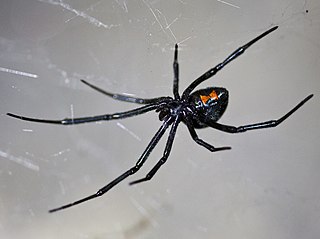
Latrodectus is a broadly distributed genus of spiders with several species that, together, are referred to as true widows. This group is composed of those often loosely called black widow spiders, brown widow spiders, and similar spiders. However, such general "common names" are of limited use as the diversity of species is much greater. A member of the family Theridiidae, this genus contains 32 species, which include several North American "black widows". In addition to these in North America are also the red widow Latrodectus bishopi and the brown widow Latrodectus geometricus, which, in addition to North America, has a much wider geographic distribution. Elsewhere, others include the European black widow, the Australian redback black widow, several different species in Southern Africa that can be called Button spiders, and the South American black widow spiders. Species vary widely in size. In most cases, the females are dark-coloured, but some may have lighter bodies or even reddish. Many can have red, white or brown markings on the upper-side (dorsal) of the abdomen. Some can be readily identifiable by reddish markings on the central underside (ventral) abdomen, which are often hourglass-shaped.

The Pholcidae are a family of araneomorph spiders. The family contains over 1,800 pholcids, including those commonly known as the marbled cellar spider , daddy long-legs spider, granddaddy long-legs spider, carpenter spider, daddy long-legger, vibrating spider, gyrating spider, long daddy, and skull spider. The family, first described by Carl Ludwig Koch in 1850, is divided into 94 genera.

Ground spiders comprise Gnaphosidae, the seventh largest spider family with nearly 2,000 described species in over 100 genera distributed worldwide. There are 105 species known to central Europe, and common genera include Gnaphosa, Drassodes, Micaria, Cesonia, Zelotes and many others. They are closely related to Clubionidae. At present, no ground spiders are known to be seriously venomous to humans.

Anatea formicaria is an ant-mimicking spider. It is only known from the rain forest of New Caledonia. Before 1967, it was considered to belong to the family Clubionidae. It was placed there based on the ant-like outward modifications and male genitalia, which superficially resemble those of the genus Micaria. In fact it is closely related to the genera Euryopis and possibly Achaearanea.

Lachesilla is the main genus in the psocopteran family Lachesillidae. There are at least 310 described species in Lachesilla. Frequent species in the Northern hemisphere include Lachesilla quercus and Lachesilla pedicularia. Some species are localized: Lachesilla merzi has been collected only once in Spain and Lachesilla rossica, apart from the original specimens that were found in southern Russia, is only known from the Valley of the Allondon river, near Geneva, Switzerland.
Agyneta micaria is a species of sheet weaver found in the United States and Canada. It was described by Emerton in 1882.

Micaria is a genus of ground spiders that was first described by Niklas Westring in 1851. They are 1.3 to 6.5 millimetres long.

Micaria pulicaria, the glossy ant spider, is a species of ground spider from the family Gnaphosidae with a Holarctic distribution.
Reo eutypus is a spider in the family Mimetidae, in the infraorder Araneomorphae . It is found in the USA.
Sosticus insularis is a spider in the family Gnaphosidae, in the infraorder Araneomorphae . The distribution range of Sosticus insularis includes the USA and Canada.
Philodromus anomalus is a spider in the family Philodromidae, in the infraorder Araneomorphae . It is found in the USA.

Theridion pennsylvanicum is a spider in the family Theridiidae, in the infraorder Araneomorphae . The distribution range of Theridion pennsylvanicum includes the USA and Canada.

Aphileta misera is a species of dwarf spider in the family Linyphiidae. It is found in North America, Europe, and Russia.

Antrodiaetus pugnax is a species of folding-door spider in the family Antrodiaetidae. It is found in the United States.
Micaria pasadena is a species of ground spider in the family Gnaphosidae. It is found in the United States and Mexico.
Micaria gertschi is a species of ground spider in the family Gnaphosidae. It is found in the United States and Canada.
Micaria longispina is a species of ground spider in the family Gnaphosidae. It is found in the United States and Canada.
Micaria longipes is a species of ground spider in the family Gnaphosidae. It is found in North America.









